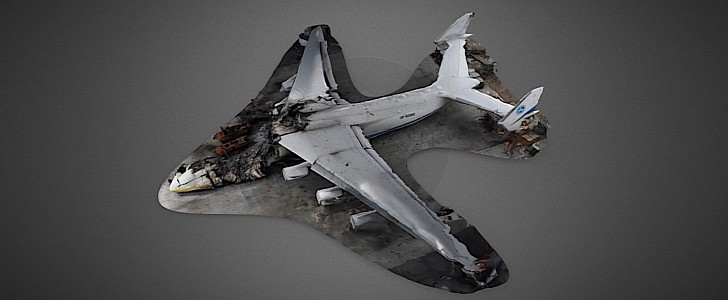Photogrammetry is described as the science of getting detailed info about objects by painstakingly analyzing, interpreting, and stitching back together available images of said objects. It’s also the process an aerospace engineering student named Simeon Schmauß used to put together this incredible 3D model of what was once the world’s largest aircraft in terms of payload.
Born in the 1980s as a strategic airlift aircraft, the Antonov An-225 Mriya was for decades the go-to platform for people and companies in need of moving large and incredibly heavy cargo by air.
During its time in the world’s skies, the Mriya managed to put some 240 world records to its name, it was capable of launching spacecraft from underneath its belly, and was an overall sight to behold. That’s until the Russians, in their failed push to take over all of Ukraine, blew it to smithereens at the airport in Hostomel where it was parked.
Being nothing short of a symbol of Ukraine, the Mriya will probably be revived (and by that we mean a new one will be built from the ground up) once the war in the country ends. That much was promised by Ukrainian president Volodymyr Zelensky, who said the plane would be brought back in honor of the country’s pilots who were killed in the fighting.
What’s more, back in March, the Antonov company launched a call to action for the revival of the aircraft and asked heads of states and governments, companies, and even fans and aviation enthusiasts to contribute whatever they could for the project.
Until we get to see the 225 back in the air, the 3D model Schmauß put together paints a pretty good picture of where the Russians hit the plane, how it was blown to bits, and what’s left of it. Two versions of the model are available, one showing both the plane and the hangar it was parked in, and the other the plane alone.
The student says he used for the model footage captured by a drone back in April and fixed it by means of specialized software where fixes were needed. Also, we’re warned some underlying geometry could be inaccurate in places with bad texture quality, but that doesn’t diminish the impact of the rendering in the slightest.
During its time in the world’s skies, the Mriya managed to put some 240 world records to its name, it was capable of launching spacecraft from underneath its belly, and was an overall sight to behold. That’s until the Russians, in their failed push to take over all of Ukraine, blew it to smithereens at the airport in Hostomel where it was parked.
Being nothing short of a symbol of Ukraine, the Mriya will probably be revived (and by that we mean a new one will be built from the ground up) once the war in the country ends. That much was promised by Ukrainian president Volodymyr Zelensky, who said the plane would be brought back in honor of the country’s pilots who were killed in the fighting.
What’s more, back in March, the Antonov company launched a call to action for the revival of the aircraft and asked heads of states and governments, companies, and even fans and aviation enthusiasts to contribute whatever they could for the project.
Until we get to see the 225 back in the air, the 3D model Schmauß put together paints a pretty good picture of where the Russians hit the plane, how it was blown to bits, and what’s left of it. Two versions of the model are available, one showing both the plane and the hangar it was parked in, and the other the plane alone.
The student says he used for the model footage captured by a drone back in April and fixed it by means of specialized software where fixes were needed. Also, we’re warned some underlying geometry could be inaccurate in places with bad texture quality, but that doesn’t diminish the impact of the rendering in the slightest.
Photogrammetric 3D model of Antonov An-225 "Mriya", the world's largest plane. She was destroyed in February during the early days of the 2022 Russian invasion of Ukraine.#Ukraine @AntonovCompany #Mriya
— Simeon Schmauß (@stim3on) May 22, 2022
Interactive version: https://t.co/oz6eBZb0r4 pic.twitter.com/2MR7Bkpnki









